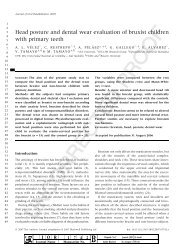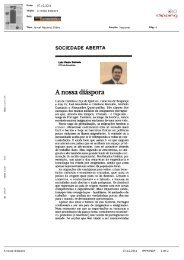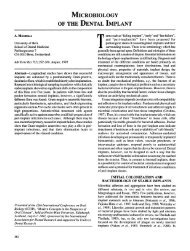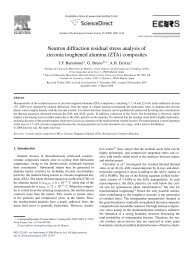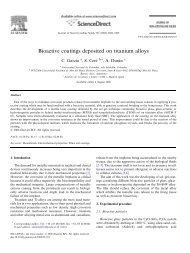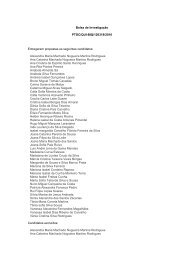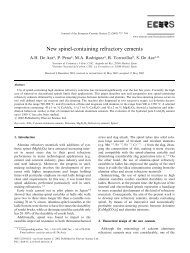Nanohydroxyapatite microspheres as delivery system.pdf - IBMC ...
Nanohydroxyapatite microspheres as delivery system.pdf - IBMC ...
Nanohydroxyapatite microspheres as delivery system.pdf - IBMC ...
You also want an ePaper? Increase the reach of your titles
YUMPU automatically turns print PDFs into web optimized ePapers that Google loves.
<strong>Nanohydroxyapatite</strong> <strong>microspheres</strong> <strong>as</strong> <strong>delivery</strong> <strong>system</strong><br />
for antibiotics: Rele<strong>as</strong>e kinetics, antimicrobial<br />
activity, and interaction with osteobl<strong>as</strong>ts<br />
M.P. Ferraz, 1,2 A.Y. Mateus, 1,3 J.C. Sousa, 2 F.J. Monteiro 1,3<br />
1 INEB-Instituto de Engenharia Biomédica, Laboratório de Biomateriais, Rua do Campo Alegre,<br />
823, 4150-180 Porto, Portugal<br />
2 Faculdade de Ciênci<strong>as</strong> da Saúde da Universidade Fernando Pessoa, Rua Carlos da Maia, 296,<br />
4200-150 Porto, Portugal<br />
3 Departamento de Engenharia Metalúrgica e Materiais, Faculdade de Engenharia da Universidade do Porto,<br />
Rua Roberto Fri<strong>as</strong>, 4200-466 Porto, Portugal<br />
Received 21 June 2006; revised 4 October 2006; accepted 25 October 2006<br />
Published online 24 January 2007 in Wiley InterScience (www.interscience.wiley.com). DOI: 10.1002/jbm.a.31151<br />
Abstract: Severe periodontitis treatment, where m<strong>as</strong>sive<br />
alveolar bone loss occurs, involves bone defect filling and<br />
intensive <strong>system</strong>ic log-term antibiotics administration. This<br />
study aims at developing novel injectable drug <strong>delivery</strong><br />
<strong>system</strong>s (nanohydroxyapatite <strong>microspheres</strong>) with the drug<br />
rele<strong>as</strong>ing capability for periodontitis treatment and simultaneously<br />
initiating the osteointegration process. Materials<br />
were characterized by XRD, SEM, inverted stand optical<br />
microscope analysis, and mercury porosimetry method.<br />
Amoxicillin, amoxicillin þ clavulanic acid, and erythromycin<br />
were the antibiotics used. Rele<strong>as</strong>e properties during<br />
28 days from the hydroxyapatite (HA) granules, and two<br />
types of nanoHA <strong>microspheres</strong> were investigated. Biocompatibility<br />
w<strong>as</strong> <strong>as</strong>sessed by cytotoxicity <strong>as</strong>says. HA granules<br />
were inadequate, rele<strong>as</strong>ing all antibiotic during the first<br />
hours. The concentration of antibiotics rele<strong>as</strong>ed in the first<br />
days from HA-2 w<strong>as</strong> higher than from HA-1 <strong>microspheres</strong>,<br />
because of the incre<strong>as</strong>ed porosity and surface area. The<br />
rele<strong>as</strong>e profiles (f<strong>as</strong>t initial rele<strong>as</strong>e followed by long-term<br />
sustained rele<strong>as</strong>e) of effective doses of antibiotics make<br />
these <strong>system</strong>s good alternatives for antibiotics <strong>delivery</strong>.<br />
Osteobl<strong>as</strong>ts proliferated well on both types of <strong>microspheres</strong>,<br />
being cell growth enhanced in the presence of antibiotics.<br />
Erythromycin presented the most beneficial effect. Combining<br />
the sustained antibiotic rele<strong>as</strong>e with the osteoconduction,<br />
resorbability, and potential use <strong>as</strong> injectable bone<br />
filling material of porous HA <strong>microspheres</strong>, these <strong>system</strong>s<br />
provided a forth fold beneficial effect. Ó 2007 Wiley Periodicals,<br />
Inc. J Biomed Mater Res 81A: 994–1004, 2007<br />
Key words: drug rele<strong>as</strong>e; microsphere; cytotoxicity; antibacterial;<br />
nanoparticles; hydroxyapatite<br />
INTRODUCTION<br />
Periodontitis is an oral dise<strong>as</strong>e that promotes, in<br />
its more severe form, m<strong>as</strong>sive alveolar bone loss. 1,2<br />
The usual treatment of this dise<strong>as</strong>e involves <strong>system</strong>ic<br />
administration of antibiotics in high dosages for long<br />
periods of time. 3 In the treatment of such infections,<br />
where v<strong>as</strong>cularity is compromised, obtaining effective<br />
local antibiotic concentrations by parenteral<br />
administration is difficult, 4 thus the <strong>delivery</strong> of an<br />
Correspondence to: M.P. Ferraz; e-mail: mpferraz@ufp.pt<br />
Contract grant sponsor: FCT-Fundação para a Ciência e<br />
Tecnologia, project Gaucher II; contract grant number:<br />
POCTI/FCB/41523/2001<br />
Contract grant sponsor: FCT-Fundação para a Ciência e<br />
Tecnologia; contract grant number: SFRH/BD/16616/2004<br />
' 2007 Wiley Periodicals, Inc.<br />
active antimicrobial agent directly to the site of infection<br />
represents a viable alternative treatment. 5–12<br />
Several have reported the use of hydroxyapatite<br />
(HA) <strong>as</strong> a drugs carrier because of its adequate mechanical<br />
properties and composition similarity to<br />
mineral bone and suggest that it may be used <strong>as</strong> a<br />
bone substitute. 6,13–16<br />
Biomaterials b<strong>as</strong>ed on calcium phosphates are currently<br />
available <strong>as</strong> blocks and <strong>as</strong> granules, <strong>as</strong> well <strong>as</strong><br />
porous structures. Macroporous blocks are brittle and<br />
difficult to shape. 15,17 In addition, they cannot fit<br />
tightly to the surface or the defects, preventing the<br />
osteoconductive process. 18 On the other hand, granules<br />
present difficulties to handle and keep in place<br />
after implantation. These are limited to be used to fill<br />
cavities of extremity fractures, hence, an injectable<br />
and biodegradable support material would be ideal. 19<br />
HA particle size is a relevant factor for in vitro cell<br />
activity, and is a parameter of great importance for
NANOHYDROXYAPATITE MICROSPHERES AS DELIVERY SYSTEM FOR ANTIBIOTICS 995<br />
injectability handling. 19–22 Desired characteristics of<br />
HA are fine and uniform particle size in the nanometer<br />
range, ph<strong>as</strong>e homogeneity, and reduced<br />
degree of particle agglomeration. Bone exhibits natural<br />
HA crystals with needle-like or rod-like shapes<br />
well arranged within the polymeric matrix of collagen<br />
type I. These natural nanoparticles, formed in<br />
physiological environment, have a more dynamic<br />
response, when compared with synthetic materials<br />
with larger sized particle. 20–24<br />
<strong>Nanohydroxyapatite</strong> <strong>microspheres</strong> intended to be<br />
used <strong>as</strong> injectable bone filling material or <strong>as</strong> enzyme<br />
<strong>delivery</strong> matrices can also be used <strong>as</strong> antibiotic<br />
rele<strong>as</strong>ing materials. 25,26<br />
The aim of this study consisted in attempting to<br />
use HA loaded with an antibiotic, to be used <strong>as</strong> a<br />
local drug <strong>delivery</strong> <strong>system</strong>, <strong>as</strong>sociating the drug rele<strong>as</strong>e<br />
capability for the periodontitis treatment with<br />
the possibility of simultaneously initiating the process<br />
of osteointegration. Therefore three types of HA materials<br />
were tested: dense granules and two different<br />
types of nanohydroxyapatite <strong>microspheres</strong>, intended<br />
to be used <strong>as</strong> injectable bone filling materials.<br />
The resident oral microflora is diverse and consist<br />
of a wide range of species of microrganisms. It is<br />
estimated that about 400 different species are able to<br />
colonize the mouth and any individual may typically<br />
harbor 150 or more different species. Among these,<br />
only a few are considered to be pathogens <strong>as</strong>sociated<br />
with periodontal dise<strong>as</strong>e. 27 The choice of antimicrobial<br />
agent must be b<strong>as</strong>ed on the bacterial aetiology<br />
of the infection. And, <strong>as</strong> there are many bacteria<br />
involved in the periodontal dise<strong>as</strong>e, the choice of<br />
one single antimicrobial agent may not be suitable.<br />
However there are several antibiotics extensively investigated<br />
for <strong>system</strong>ic use namely: ampicillin, amoxicillin,<br />
tetracycline, minocycline, erythromycin, clindamycin,<br />
and metronidazole. 4<br />
In this study, amoxicillin with and without clavulanic<br />
acid and erythromycin, antibiotics already in<br />
use for oral and parenteral administration in the<br />
treatment of periodontitis, 28 were tested to be used<br />
for controlled local <strong>delivery</strong>. The <strong>delivery</strong> <strong>system</strong>s<br />
tested (two different types of nanohydroxyapatite<br />
<strong>microspheres</strong>), were compared with dense granules<br />
behavior, and are expected to present more appropriate<br />
antibiotic rele<strong>as</strong>e kinetics.<br />
MATERIALS AND METHODS<br />
Materials preparation and characterization<br />
Preparation of HA granules<br />
The preparation methods for hydroxyapatite (HA) granules<br />
have been previously described. 14 Briefly, commercial<br />
HA (from Pl<strong>as</strong>ma Biotal, ref. P120 powder) w<strong>as</strong> uniaxially<br />
pressed to cylindrical samples (0.5 g into 16-mm diameter<br />
mold) at 288 MPa and sintered. Samples were milled and<br />
sieved to obtain 75–106 mm granules. This range of granules<br />
diameter allows for the occurrence of different sizes,<br />
improving the capacity to fill the periodontal pocket and<br />
maximizing the amount of antibiotic to be loaded and<br />
rele<strong>as</strong>ed.<br />
Synthesis of nanosized HA<br />
Aqueous solutions of calcium hydroxide (Ca(OH) 2 ) and<br />
orthophosphoric acid (H 3 PO 4 , 85%), both of analytical<br />
grade, were used <strong>as</strong> reactants for the preparation of two<br />
different types of HA nanoparticles. The first HA powder<br />
(HA-1) w<strong>as</strong> synthesized according to the following procedure.<br />
Firstly, 1 L of an aqueous suspension of H 3 PO 4<br />
(0.6M) w<strong>as</strong> added drop-by-drop, slowly to a 1 L of an<br />
aqueous suspension of Ca(OH) 2 (1M) while stirring vigorously<br />
for about 2 h at room temperature. Concentrated<br />
NaOH w<strong>as</strong> added until a final pH of 10.5 w<strong>as</strong> obtained.<br />
The white solution obtained w<strong>as</strong> w<strong>as</strong>hed using de-ionized<br />
water and dried in at 808C for 24 h. The other HA powder<br />
(HA-2) w<strong>as</strong> synthesized in a similar f<strong>as</strong>hion, with the difference<br />
of the sodium dodecyl sulphate addition (10 g) to<br />
the calcium solution.<br />
Alginate/HA <strong>microspheres</strong> preparation<br />
The <strong>microspheres</strong> were prepared following a methodology<br />
developed in our group, and previously described. 25,29<br />
Briefly, pharmaceutical-grade sodium alginate (Protanal 10/<br />
60 LS) with a high a-L-guluronic acid content (65–75%, <strong>as</strong><br />
specified by the manufacturer) w<strong>as</strong> kindly donated by Pronova<br />
Biopolymers and used without further purification.<br />
Na-alginate (1.5 g) w<strong>as</strong> dissolved in 50 mL of distilled and<br />
de-ionized water until total homogenization, where HA<br />
powder (70 mm) w<strong>as</strong> added to the alginate solution in a ratio<br />
of 1:4 w/w until complete dissolution. This p<strong>as</strong>te w<strong>as</strong><br />
extruded drop-wise into a 0.1M CaCl 2 crosslinking solution,<br />
where spherical-shaped particles instantaneously formed<br />
and were allowed to harden for 30 min. The size of the<br />
<strong>microspheres</strong> w<strong>as</strong> controlled by regulating the extrusion<br />
flow rate (Encapsulation Unit VAr 1-J1, Nisco) using a single<br />
syringe infusion pump (EW 47-900-00, Cole Palmer) and<br />
by applying a coaxial air stream. For the HA-1 sample<br />
extrusion flow rate w<strong>as</strong> 20 mL/h while for the HA-2 sample<br />
w<strong>as</strong> 40 mL/h. At completion of the gelling period,<br />
<strong>microspheres</strong> were recovered and rinsed in water to remove<br />
CaCl 2 in excess. Finally they were dried overnight in a vacuum<br />
oven at 308C, and sintered at 11008C for1h. 30<br />
Materials characterization<br />
Materials were characterized by X-ray diffraction (XRD),<br />
scanning electron microscopy (SEM), transmission electron<br />
microscopy (TEM), inverted stand optical microscope analysis,<br />
and mercury porosimetry method.<br />
Journal of Biomedical Materials Research Part A DOI 10.1002/jbm.a
996 FERRAZ ET AL.<br />
Drug loading<br />
Amoxicillin, erythromycin, and amoxicillin þ clavulanic<br />
acid (7:1) solutions of concentrations 4, 2, and 4 mg/mL,<br />
respectively were prepared in tris-buffer solution (pH 7.4).<br />
Then, 0.5 g of HA particles were immersed in 10 mL of<br />
antibiotics solution at 378C for 48 h. The drug solution w<strong>as</strong><br />
then removed and the particles were dried.<br />
Rele<strong>as</strong>e kinetics and bioactivity<br />
The antibiotic loaded ceramics were immersed in 10 mL<br />
of simulated body fluid (SBF, a protein free solution with<br />
ionic concentrations and pH similar to the pl<strong>as</strong>ma of blood)<br />
at 378C. To determine the concentration of amoxicillin and<br />
erythromycin rele<strong>as</strong>ed from the ceramic into the SBF, 2 mL<br />
of SBF were withdrawn and replaced by fresh 2 mL SBF after1,3,6,24,and48h.At72h,50%oftheSBFvolumew<strong>as</strong><br />
replaced by fresh solution and from then onwards every<br />
24 h up to 28 days. The eluted SBF samples were frozen at<br />
48C for concentration me<strong>as</strong>urements and microbiology<br />
<strong>as</strong>say. Control experiment using antibiotic-free ceramic samples<br />
w<strong>as</strong> performed under the same experimental conditions<br />
(negative control). All tests were performed in triplicate.<br />
The concentration and the bioactivity of the rele<strong>as</strong>ed antibiotic<br />
were checked using the diffusion method. Staphylococcus<br />
aureus ATCC 29213 w<strong>as</strong> used to test erythromycin<br />
and amoxicillin þ clavulanic acid, and Escherichia coli<br />
ATCC 25922 w<strong>as</strong> used to test amoxicillin. E. coli w<strong>as</strong> used<br />
to test amoxicillin and not erythromycin because it is only<br />
susceptible to the first. Oppositely, S. aureus is susceptible<br />
to erythromycin and can be used to test it. Staphylococcus<br />
aureus ATCC 29213, is a bacterial strain resistant to amoxicillin<br />
and susceptible to amoxicillin þ clavulanic acid,<br />
therefore, due to the presence of b–lactameses. It can be<br />
used to test the <strong>delivery</strong> of this combination <strong>as</strong> these two<br />
substances should be delivered at similar rates.<br />
Nutrient agar plate inoculated with S. aureus and E. coli<br />
w<strong>as</strong> used to create a 10 6 colony-forming units/mL suspension<br />
in NaCl to match 0.5 Mcfarland equivalence turbidity<br />
standard in ambient light. Bacteria suspension of 1.5 mL<br />
w<strong>as</strong> incorporated in 250 mL of nutrient agar medium heated<br />
at 508C. The agar w<strong>as</strong> poured in sterile plates and left at<br />
room temperature. Samples of 70 mL were deposited in triplicate<br />
into 10-mm stainless steel cylinders inserted into the<br />
agar. Samples were located in different are<strong>as</strong> in the plates<br />
and left at room temperature for about 30 min before incubation<br />
at 378C. After 18 h of incubation, the diameters of inhibition<br />
zones were me<strong>as</strong>ured and expressed <strong>as</strong> mean 6 SD<br />
<strong>as</strong> a function of time. The corresponding negative control<br />
samples (solution incubated with ceramic without antibiotic)<br />
were me<strong>as</strong>ured using the same methodology. In addition,<br />
standard solutions of known antibiotic concentrations were<br />
prepared and tested with the same method to calculate the<br />
unknown antibiotic concentration in the samples.<br />
Cytotoxicity<br />
Two different types of cytotoxicity testing were performed.<br />
Culture of MG63 human osteobl<strong>as</strong>t cell line in the<br />
presence of different antibiotics concentrations (qualitative<br />
cytotoxicity), and direct growth and adhesion of MG63<br />
cells on the surface of materials loaded with antibiotics.<br />
The growth of MG63 cells w<strong>as</strong> evaluated using neutral red<br />
<strong>as</strong>say (NR), in which a colored reaction product is generated<br />
in viable cells. Thus, the absorbance values obtained<br />
are directly proportional to the number of living cells that<br />
are present. Therefore changes in absorbance can be used<br />
to estimate cell proliferation.<br />
Growth of human osteobl<strong>as</strong>ts—Qualitative<br />
cytotoxicity<br />
MG63 cells, expressing a number of features characteristic<br />
of osteobl<strong>as</strong>ts were cultured at 378C in a humidified<br />
atmosphere of a 5% CO 2 in air, in a-minimum essential<br />
medium (a-MEM) (Gibco), 10% foetal calf serum (FCS)<br />
(Gibco), 1% v/v fungizone (Gibco), 1% v/v penicillin/<br />
streptomycin (Gibco), and supplemented with 500 mL of<br />
<strong>as</strong>corbic acid 50 mg/mL. The medium w<strong>as</strong> changed every<br />
third day and, for sub-culture, the cell monolayer w<strong>as</strong><br />
w<strong>as</strong>hed twice with phosphate-buffered saline (PBS)<br />
(Gibco) and incubated with trypsin-EDTA solution (0.25%<br />
trypsin, 1 mM EDTA; Gibco) to detach the cells. The effect<br />
of trypsin w<strong>as</strong> then inhibited by adding the complete medium<br />
at room temperature. The cells were w<strong>as</strong>hed twice<br />
by centrifugation and resuspended in complete medium<br />
and seeded in 24-well dishes at a density of 10 4 cells/well.<br />
MG63 cells were cultured for a period of 10 days, in the<br />
above described experimental conditions <strong>as</strong> a control, and<br />
supplemented with: (i) amoxicillin 4, 10, 25, 100, and<br />
200 mg/mL; (ii) amoxicillin þ clavulanic acid (7:1) 4, 10,<br />
25, 100, and 200 mg/mL; and (iii) erythromycin 4, 10, 25,<br />
100, and 200 mg/mL.<br />
The quantification of viable cells w<strong>as</strong> performed at days<br />
1, 6, and 10 and <strong>as</strong>sessed by neutral red <strong>as</strong>say (NR).<br />
Briefly, the culture medium w<strong>as</strong> discarded and replaced<br />
by fresh medium containing 50 mg/mL NR (Sigma). Plates<br />
were incubated at 378C for 3 h. At the end, the supernatant<br />
w<strong>as</strong> discarded and cells were w<strong>as</strong>hed twice with PBS. The<br />
NR absorbed by the cells w<strong>as</strong> extracted with 1% v/v acetic<br />
acid in 50% v/v aqueous ethanol. After being well homogenized<br />
on a shaker platform, the supernatants were transferred<br />
to another 96-well plate, and the optical density w<strong>as</strong><br />
read at 540 nm in a microplate spectrophotometer.<br />
Direct growth of MG63 cells on the surface<br />
of materials loaded with antibiotics<br />
MG63 cells were cultured at 378C inahumidifiedatmosphere<br />
of a 5% CO 2 in air, in a-minimum essential medium<br />
(a-MEM) (Gibco), 10% foetal calf serum (FCS) (Gibco), 1%<br />
v/v fungizone (Gibco) and 0.5% v/v gentamicin (Gibco).<br />
Cultures were maintained until confluence and, at this stage,<br />
adherent cells were enzymatically rele<strong>as</strong>ed with trypsin and<br />
seeded in a 96-well dishes at a density of 3.6 10 4 cells/<br />
cm 2 . Cells were cultured for periods up to 5 days, in the<br />
same experimental conditions previously described on the<br />
surface of TCPS (Control) and on the following sterilized<br />
materials (14 mg/well): HA granules, HA-1 <strong>microspheres</strong>,<br />
Journal of Biomedical Materials Research Part A DOI 10.1002/jbm.a
NANOHYDROXYAPATITE MICROSPHERES AS DELIVERY SYSTEM FOR ANTIBIOTICS 997<br />
Figure 1.<br />
SEM micrograph of HA-1 <strong>microspheres</strong> of HA-1 (A: 50; B: 30,000).<br />
and HA-2 <strong>microspheres</strong> previously immersed in solutions<br />
prepared <strong>as</strong> described earlier.<br />
The quantification of viable cells w<strong>as</strong> performed at days<br />
1, 3, and 5 and <strong>as</strong>sessed by neutral red <strong>as</strong>say (NR), using<br />
the above described procedure.<br />
Materials characterization<br />
RESULTS<br />
Quantitative ph<strong>as</strong>e analysis of HA granules<br />
obtained by XRD showed that the only ph<strong>as</strong>e present<br />
w<strong>as</strong> HA (99.7%). Granules size varied between<br />
75 and 106 mm.<br />
Both microsphere types HA-1 and HA-2, were<br />
characterized using XRD, SEM, inverted optical microscopy,<br />
and mercury porosimetry analysis. These<br />
results are described briefly, <strong>as</strong> detailed materials<br />
characterization is not the aim of this study. More<br />
detailed materials characterization is published elsewhere.<br />
31 HA-1 is composed by pure monoclinic HA,<br />
where<strong>as</strong> HA-2 is composed by a mixture of monoclinic<br />
HA and a small percentage of b–TCP. Concerning<br />
porosity, HA-1 showed lower pore diameter than<br />
HA-2, 0.53 and 0.82 mm, respectively. Similarly, HA-1<br />
presented lower theoretical porosity than HA-2. In<br />
Figure 1 it can be seen, <strong>as</strong> an example SEM images of<br />
HA-1 <strong>microspheres</strong>.<br />
The average diameter of HA <strong>microspheres</strong> w<strong>as</strong><br />
450 6 25 mm (n ¼ 20), and after the sintering process<br />
that generated the <strong>microspheres</strong>. By TEM observation<br />
it w<strong>as</strong> possible to observe that HA crystallites<br />
presented nanometer size range (less than 100-nm in<br />
length) for both HA-1 and HA-2. These nanoparticles<br />
appeared <strong>as</strong> dispersed aggregates of crystallites.<br />
Rele<strong>as</strong>ing profile and biological activity<br />
A linear relationship between the diameter of the<br />
inhibition zone and the standard concentration of<br />
the antibiotics tested w<strong>as</strong> observed, being R 2 ¼<br />
0.984, 0.991, and 0.983 for amoxicillin, amoxicillin<br />
þ clavulanic acid, and erythromycin, respectively.<br />
These calibration curves were used to calculate the<br />
amount of antibiotics rele<strong>as</strong>ed from the materials.<br />
Figure 2 shows, <strong>as</strong> an example, the bacteria inhibition<br />
zones around the wells that were initially filled<br />
with 70 mL of amoxicillin rele<strong>as</strong>ed from HA-1 <strong>microspheres</strong><br />
after different immersion periods. The bacterial<br />
inhibition <strong>as</strong>say revealed that all antibiotics<br />
rele<strong>as</strong>ed from the materials retained their biological<br />
activity. No inhibitory effect w<strong>as</strong> detected for the control<br />
samples (immersed in antibiotic-free solution).<br />
This indicates that the inhibitory effect w<strong>as</strong> due to the<br />
antibiotics being rele<strong>as</strong>ed from the materials.<br />
Figures 3, 4, and 5 show the bacteria inhibition zone<br />
diameter (A) and the mean cumulative concentration<br />
of rele<strong>as</strong>ed amoxicillin, amoxicillin þ clavulanic acid,<br />
and erythromycin, respectively (B), <strong>as</strong> a function of<br />
immersion time. The variation of the amount rele<strong>as</strong>ed<br />
antibiotic is inserted in Figures 3, 4, and 5(a).<br />
For the HA granules, there w<strong>as</strong> an initial burst of<br />
rele<strong>as</strong>e for the three antibiotics. After 48 h the<br />
Figure 2. Bacteria inhibition zones around the wells that<br />
were initially filled with 70 mL of amoxicillin rele<strong>as</strong>ed from<br />
HA-1 <strong>microspheres</strong> after different elution periods. [Color<br />
figure can be viewed in the online issue, which is available<br />
at www.interscience.wiley.com.]<br />
Journal of Biomedical Materials Research Part A DOI 10.1002/jbm.a
998 FERRAZ ET AL.<br />
Figure 3. Bacteria inhibition zone diameter (A) and the mean cumulative concentration of rele<strong>as</strong>ed amoxicillin (B) <strong>as</strong> a<br />
function of rele<strong>as</strong>e time. The variation of the rele<strong>as</strong>ed amoxicillin (mg/h) is inserted in (A).<br />
rele<strong>as</strong>ed antibiotic stood below the minimal inhibitory<br />
concentration (MIC) for all three antibiotics tested.<br />
The MIC is the lowest concentration of a drug that<br />
prevents growth of a particular pathogen.<br />
For both, HA-1 and HA-2 <strong>microspheres</strong>, during<br />
the period of this study (672 h) the rele<strong>as</strong>ed antibiotics<br />
stood above the MIC.<br />
Figure 3(a) shows that HA-1 <strong>microspheres</strong> exhibit<br />
a decre<strong>as</strong>e in the concentration of rele<strong>as</strong>ed amoxicillin<br />
from 0 to 72 h, followed by a stable period with<br />
low variation in the rele<strong>as</strong>ed concentration. HA-2<br />
<strong>microspheres</strong> have a higher and stable rele<strong>as</strong>e rate in<br />
the early periods (till 240 h), followed by a rele<strong>as</strong>e<br />
rate lower than HA-1. These results can be confirmed<br />
in Figure 3(b) where it may be seen that for<br />
both <strong>microspheres</strong> the rele<strong>as</strong>ing profile showed initial<br />
rele<strong>as</strong>e bursts followed by sustained rele<strong>as</strong>e of<br />
amoxicillin. On the period between 72 and 240 h<br />
HA-2 <strong>microspheres</strong> presented a higher rele<strong>as</strong>e rate,<br />
after which both materials had a similar behavior.<br />
In what concerns the rele<strong>as</strong>ing behavior of amoxicillin<br />
þ clavulanic acid, Figure 4(a) shows that both<br />
types of <strong>microspheres</strong> have a decre<strong>as</strong>e in the<br />
rele<strong>as</strong>ed concentrations of amoxicillin from 0 to 72 h,<br />
Journal of Biomedical Materials Research Part A DOI 10.1002/jbm.a
NANOHYDROXYAPATITE MICROSPHERES AS DELIVERY SYSTEM FOR ANTIBIOTICS 999<br />
Figure 4. Bacteria inhibition zone diameter (A) and the mean cumulative concentration of rele<strong>as</strong>ed amoxicillin þ clavulanic<br />
acid (B) <strong>as</strong> a function of rele<strong>as</strong>e time. The variation of the rele<strong>as</strong>ed amoxicillinþclavulanic acid (mg/h) is inserted in (A).<br />
being HA-1 the one with a higher variation. Between<br />
72 and 240 h a relatively stable period in terms of<br />
rele<strong>as</strong>ed antibiotic concentration occur. However,<br />
because of the initial variation found for HA-1<br />
<strong>microspheres</strong>, HA-2 had higher rele<strong>as</strong>e concentration.<br />
After 400 h the two materials have nearly the<br />
same rele<strong>as</strong>ed concentration of antibiotic. In what<br />
concerns Figure 4(b), similarly to what happened<br />
with amoxicillin, it may be observed that for both<br />
types of <strong>microspheres</strong> the rele<strong>as</strong>ing profile showed<br />
initial rele<strong>as</strong>e bursts followed by a sustained rele<strong>as</strong>e<br />
of amoxicillin þ clavulanic acid. However, HA-2<br />
<strong>microspheres</strong> presented a higher rele<strong>as</strong>e rate during<br />
all the tested period.<br />
Concerning the behavior of erythromycin, in Figure<br />
5(a) it may be seen that both types of <strong>microspheres</strong><br />
have similar behaviors in the early periods<br />
(between 0 and 72 h). Both show a high decre<strong>as</strong>e in<br />
the rele<strong>as</strong>ed concentration of erythromycin in the first<br />
6 h, followed by a stable period with low variation in<br />
the rele<strong>as</strong>ed concentration. HA-1 <strong>microspheres</strong> have a<br />
decre<strong>as</strong>e in the rele<strong>as</strong>ed concentration of erythromycin<br />
from 72 to 240 h, followed by a stable period with<br />
low variation in the rele<strong>as</strong>ed concentration. On the<br />
Journal of Biomedical Materials Research Part A DOI 10.1002/jbm.a
1000 FERRAZ ET AL.<br />
Figure 5. Bacteria inhibition zone diameter (A) and the mean cumulative concentration of rele<strong>as</strong>ed erythromycin (B) <strong>as</strong> a<br />
function of rele<strong>as</strong>e time. The variation of the rele<strong>as</strong>ed erythromycin (mg/h) is inserted in (A).<br />
other hand HA-2 <strong>microspheres</strong> have a higher and stable<br />
rele<strong>as</strong>e rate in the periods of 72 to 240 h followed<br />
by a decre<strong>as</strong>e in the rele<strong>as</strong>e rate. Analyzing Figure 5(b),<br />
it can be e<strong>as</strong>ily seen that the main difference between<br />
the two types of <strong>microspheres</strong> occurred in the period<br />
of 72 to 576 h, being HA-2 the material with higher<br />
rate of rele<strong>as</strong>ed antibiotic.<br />
Cytotoxicity<br />
As described above, the growth of MG63 cells w<strong>as</strong><br />
evaluated using neutral red <strong>as</strong>say, in which a colored<br />
reaction product is generated in viable cells.<br />
Thus, the absorbance values obtained are directly<br />
proportional to the number of living cells that are<br />
present. Therefore changes in absorbance can be<br />
used to estimate cell proliferation.<br />
Triplicate culture experiments were performed.<br />
The results are shown <strong>as</strong> the arithmetic means 6<br />
the standard deviation (SD). Analysis of the results<br />
w<strong>as</strong> carried out using SPSS software applying<br />
the Student’s t-test, with a significance level of<br />
p ¼ 0.05.<br />
Journal of Biomedical Materials Research Part A DOI 10.1002/jbm.a
NANOHYDROXYAPATITE MICROSPHERES AS DELIVERY SYSTEM FOR ANTIBIOTICS 1001<br />
Figure 6. Effects of the presence of different concentrations (4, 10, 25, 100, and 200 mg/mL) of amoxicillin (A), amoxicillin<br />
þ clavulanic acid (B) and erythromycin (C) on the growth of MG63 cells. MG63 cells were grown on TCPS with and without<br />
(control) antibiotics supplement, <strong>as</strong> described in materials and methods. Results are expressed <strong>as</strong> the average incre<strong>as</strong>e<br />
in the number of cells relative to the number present initially on day 0.<br />
Growth of human osteobl<strong>as</strong>ts—Qualitative cytotoxicity<br />
The results in Figure 6 show that MG63 cells cultured<br />
on pl<strong>as</strong>tic culture dishes proliferate over a period<br />
of 10 days. Although all cultures had the same<br />
number of cells on day 1 (results not shown), at day<br />
6 the growth of MG63 cells w<strong>as</strong> elevated on cultures<br />
supplemented with antibiotics.<br />
In what concerns to culture supplemented with<br />
amoxicillin, an incre<strong>as</strong>e in the antibiotic concentration<br />
is directly related with an incre<strong>as</strong>e in cell number.<br />
The difference is more marked at day 10 for all<br />
concentrations, and at day 6 for 100 and 200 mg/mL.<br />
For the amoxicillin þ clavulanic acid supplemented<br />
cultures a very similar phenomenon w<strong>as</strong> observed,<br />
although the differences between day 6 and day 10<br />
<strong>as</strong> well <strong>as</strong> between different antibiotic concentration<br />
were less obvious. Significant statistical differences<br />
on the cell growth comparing with control (p < 0.05)<br />
were seen on 100 and 200 mg/mL supplemented cultures<br />
with amoxicillin with and without clavulanic<br />
acid.<br />
The difference between the control and antibioticgrown<br />
cells w<strong>as</strong> more pronounced with the erythromycin<br />
supplemented cultures, whose growth w<strong>as</strong><br />
markedly higher than for control cells (Fig. 6). These<br />
differences were evident at days 6 and 10 for all the<br />
tested concentrations. The growth of erythromycin<br />
supplemented cells for day 10 w<strong>as</strong> approximately<br />
37, 42, 45, 67, and 67% greater, respectively, than for<br />
the cells cultures in control conditions. In fact, significant<br />
statistical differences on the cell growth comparing<br />
with control (p < 0.05) were seen on erythromycin<br />
supplemented cultures independently on the<br />
concentration used.<br />
Direct growth of MG63 cells on the surface<br />
of materials loaded with antibiotics<br />
Results concerning neutral red <strong>as</strong>say in cultures<br />
growing on materials (HA granules and the two<br />
types of <strong>microspheres</strong> HA-1 and HA-2) with and<br />
without antibiotic are presented in Figure 7. The<br />
results are presented <strong>as</strong> percentages compared with<br />
control, being the control the material without antibiotic<br />
adsorbed. MG63 cells were also cultured on<br />
pl<strong>as</strong>tic culture dishes and proliferate over a period<br />
of 5 days for all the described conditions.<br />
On HA granules the behavior of cells were similar<br />
with and without the presence of antibiotic.<br />
For both types of <strong>microspheres</strong> the presence of<br />
antibiotics clearly enhanced cell proliferation. For<br />
HA-1 <strong>microspheres</strong> all three tested antibiotics clearly<br />
have shown benefits in cell proliferation and are<br />
statistically different from control. However, erythromycin<br />
clearly have the more pronounced effect, particularly<br />
for the initial period (day 1 and 3) the<br />
behavior of erythromycin <strong>microspheres</strong> is statistically<br />
different from the other antibiotics (p < 0.05).<br />
There is no statistic differences between amoxicillin<br />
and amoxicillin þ clavulanic acid.<br />
On HA-2 <strong>microspheres</strong> there is no significant differences<br />
between control <strong>microspheres</strong> and amoxicillin<br />
with and without clavulanic acid (p < 0.05).<br />
However, erythromycin <strong>microspheres</strong> presented en-<br />
Journal of Biomedical Materials Research Part A DOI 10.1002/jbm.a
1002 FERRAZ ET AL.<br />
Figure 7. Effect of amoxicillin (A), amoxicillin þ clavulanic acid (B) and erythromycin (C) adsorbed on HA granules,<br />
HA-1 and HA-2 <strong>microspheres</strong>, relative to the level expressed by control cells, grown on the same material without<br />
adsorbed antibiotic (defined <strong>as</strong> 100%).<br />
hancement in cell growth statistically different (p <<br />
0.05) from both antibiotic free and other studied<br />
antibiotics <strong>microspheres</strong>.<br />
DISCUSSION<br />
Penicillins act by inhibition of bacteria cell wall<br />
synthesis. They are narrow spectrum and bactericidal<br />
antibiotics. Among penicillins, amoxicillin h<strong>as</strong><br />
been favored for treatment of periodontal dise<strong>as</strong>e<br />
because of its considerable activity against several<br />
periodontal pathogens. The molecular structure of<br />
penicillins includes a b–lactam ring (with antimicrobial<br />
activity) that may be cleaved by bacterial enzymes<br />
(b-lactam<strong>as</strong>es). Some b-lactam<strong>as</strong>es have a high affinity<br />
for clavulanic acid, a b–lactam molecule without antimicrobial<br />
activity. To inhibit bacterial b-lactam<strong>as</strong>e activity,<br />
clavulanic acid h<strong>as</strong> been added successfully to<br />
amoxicillin. This combination h<strong>as</strong> been used for <strong>system</strong>ic<br />
periodontal therapy. 4<br />
Erythromycin is a macrolide antibiotic, which h<strong>as</strong><br />
an antimicrobial spectrum similar to or slightly<br />
wider than that of penicillin, and is often used for<br />
people who have an allergy to penicillins. Structurally,<br />
this macrocyclic compound contains a 14-membered<br />
lactone ring with 10 <strong>as</strong>ymmetric centers and<br />
two sugars (L-cladinose and D-desoamine), making<br />
it a compound very difficult to produce via synthetic<br />
methods. Erythromycin prevents bacteria from<br />
growing, by interfering with their protein synthesis.<br />
Erythromycin binds to the 23s rRNA molecule in the<br />
50S of the bacterial ribosome, blocking the exit of the<br />
growing peptide chain thus inhibiting the translocation<br />
of peptides. 4<br />
Therefore, amoxicillin with and without clavulanic<br />
acid <strong>as</strong> well <strong>as</strong> erythromycin, commonly used antibiotics<br />
in <strong>system</strong>ic treatments of periodontitis, can be<br />
possible alternatives for local <strong>delivery</strong> <strong>system</strong>s.<br />
Results of this study suggest that both types of<br />
HA <strong>microspheres</strong> are characterized by a highly porous<br />
structure (Fig. 1), providing large surface area<br />
for drug loading and allowing for a sustained rele<strong>as</strong>e<br />
profile over the period of study. HA granules presented<br />
an initial burst, rele<strong>as</strong>ing the entire antibiotic<br />
in the first hours.<br />
Quantitative ph<strong>as</strong>e analysis of HA granules<br />
obtained by XRD showed that the only ph<strong>as</strong>e present<br />
w<strong>as</strong> HA (99.7%). Granules size varied between<br />
75 and 106 mm, this range of granule diameter allows<br />
for the occurrence of different sizes, improving<br />
the capacity to fill the periodontal pocket and maximizing<br />
the amount of antibiotic to be rele<strong>as</strong>ed.<br />
Both <strong>microspheres</strong>, presented a rele<strong>as</strong>e profile of<br />
zero-order from 432 h till the end of the study characterized<br />
by a sustained rele<strong>as</strong>e. The rele<strong>as</strong>e kinetics<br />
of antibiotics from the <strong>microspheres</strong> w<strong>as</strong> determined<br />
by differences in composition and porosity of the<br />
materials, being the main difference observed in the<br />
early periods (0–240 for amoxicillin and amoxicillin þ<br />
clavulanic acid, and 0–432 for erythromycin). HA-1<br />
presented lower porosity than HA-2, therefore,<br />
because of the higher amount of antibiotic adsorbed<br />
on an incre<strong>as</strong>ed surface area material, the rele<strong>as</strong>e rate<br />
of HA-2 w<strong>as</strong> higher than for HA-1, for the above<br />
mentioned period.<br />
b–TCP is known to have higher dissolution rate<br />
than HA in the physiological environment, thus<br />
incre<strong>as</strong>ing in vivo resorbability. 15,32,33 Therefore, similarly<br />
to what w<strong>as</strong> found in other studies in the litera-<br />
Journal of Biomedical Materials Research Part A DOI 10.1002/jbm.a
NANOHYDROXYAPATITE MICROSPHERES AS DELIVERY SYSTEM FOR ANTIBIOTICS 1003<br />
ture, 7 the presence of b–TCP in HA-2 and not in<br />
HA-1 is related to the adsorption/rele<strong>as</strong>e behavior<br />
of antibiotics, indicating that the presence of small<br />
amounts of b–TCP might have a beneficial effect in<br />
the sustained rele<strong>as</strong>e of the studied antibiotics.<br />
The rele<strong>as</strong>e kinetics of erythromycin from the<br />
<strong>microspheres</strong> w<strong>as</strong> different from that of amoxicillin<br />
and amoxicillin þ clavulanic acid (being the rele<strong>as</strong>ing<br />
profile of the former two very similar). Erythromycin<br />
presented a more effective sustained rele<strong>as</strong>e,<br />
presenting a very high rele<strong>as</strong>e concentration till<br />
432 h. In accordance with other authors, 12,13,16 this<br />
fact can be explained by differences in the chemical<br />
structure between antibiotics, giving rise to different<br />
chemical binding (adsorption) between antibiotics<br />
and the materials.<br />
The porous structure provided by these nano-HA<br />
<strong>microspheres</strong>, with high surface are<strong>as</strong>, facilitated<br />
sustained rele<strong>as</strong>e of the tested antibiotics from both<br />
types of <strong>microspheres</strong>. The rele<strong>as</strong>e kinetics w<strong>as</strong><br />
superior to that reported for other carriers, which<br />
presented an initial burst rele<strong>as</strong>e followed by a very<br />
slow rele<strong>as</strong>e after 24 h, usually bellow MIC values.<br />
18,34–39 These rele<strong>as</strong>e profiles enable the HA<strong>microspheres</strong><br />
to fulfil an important criterion of any<br />
ideal drug <strong>delivery</strong> <strong>system</strong>, where initial high doses<br />
of drug are required for effective attack on bacteria,<br />
followed by a sustained rele<strong>as</strong>e. The initial doses<br />
provide large concentration of antibiotic needed in<br />
the period after surgery; on the other hand sustained<br />
rele<strong>as</strong>e provides continuous dosing of antibiotic for<br />
long-term treatment.<br />
The aim of the cytotoxicity tests w<strong>as</strong> to examine<br />
whether the presence of antibiotics (amoxicillin,<br />
amoxicillin þ clavulanic acid, and erythromycin)<br />
adsorbed to the materials affected the growth of<br />
MG63 cells. This cell line h<strong>as</strong> previously been used<br />
in biocompatibility studies, because it exhibits a<br />
number of features similar to those of typical human<br />
osteobl<strong>as</strong>ts. 40 The culture of MG63 cells supplemented<br />
with different concentration of the three<br />
antibiotics showed that there w<strong>as</strong> an incre<strong>as</strong>e in cell<br />
number <strong>as</strong> compared with similar cells cultured<br />
without antibiotic. This effect w<strong>as</strong> more marked for<br />
erythromycin supplemented cultures, than for the<br />
other two antibiotics, indicating that the presence of<br />
these antibiotics, particularly erythromycin, may<br />
have a beneficial effect in cell proliferation.<br />
The present study also showed that cultures of<br />
MG63 cells on HA-1 and HA-2 <strong>microspheres</strong>, where<br />
amoxicillin, amoxicillin þ clavulanic acid, and erythromycin<br />
were adsorbed, presented higher percentages<br />
of viable cells than these cells on the same<br />
materials without antibiotic. These results correlate<br />
well with those found for the MG63 cultures supplemented<br />
with the same antibiotics, and once that, <strong>as</strong><br />
it may be seen in Figure 5, the improvement on cell<br />
proliferation is concentration dependent. Therefore,<br />
the higher antibiotics rele<strong>as</strong>e rate of HA-1 <strong>microspheres</strong><br />
when compared with HA-2 in early periods,<br />
gave rise to a higher enhancement in cell proliferation<br />
on HA-1 than on HA-2, if we consider the antibiotics<br />
effect.<br />
In fact, the total amount of viable cells is very similar<br />
for HA-1 and HA-2 <strong>microspheres</strong>, and once that<br />
because of the higher surface area of HA-2 compared<br />
with HA-1 in the absence of antibiotics, the<br />
former presented lowered values of viable cells. In<br />
both cytotoxicity tests, erythromycin showed a higher<br />
beneficial effect in osteobl<strong>as</strong>ts proliferation.<br />
CONCLUSION<br />
Microspheres prepared from two types of HA<br />
nanocrystallites aggregates have shown to have<br />
chemical compositions, porosities, and surface are<strong>as</strong><br />
that provided adequate conditions for the sustained<br />
rele<strong>as</strong>e profile of amoxicillin, amoxicillin þ clavulanic<br />
acid, and erythromycin. Bactericidal tests have<br />
indicated that during the period of this study the<br />
rele<strong>as</strong>ed antibiotics had inhibitory effect on bacteria.<br />
HA granules did not present a good alternative <strong>as</strong> a<br />
<strong>delivery</strong> <strong>system</strong> for the tested antibiotics. The concentration<br />
of antibiotics rele<strong>as</strong>ed in the first days<br />
from HA-2 w<strong>as</strong> higher than from HA-1 <strong>microspheres</strong>,<br />
because of the incre<strong>as</strong>ed porosity and surface<br />
area. The rele<strong>as</strong>e profiles (f<strong>as</strong>t initial rele<strong>as</strong>e followed<br />
by a long-term sustained rele<strong>as</strong>e) of effective<br />
doses of antibiotics indicated that both alternatives<br />
were good alternatives for a <strong>delivery</strong> <strong>system</strong> of the<br />
studied drugs.<br />
Osteobl<strong>as</strong>tic cells proliferate well on the surface of<br />
both types of <strong>microspheres</strong>, being cell growth<br />
enhanced by the presence of antibiotics. Erythromycin<br />
w<strong>as</strong> the antibiotic presenting a higher beneficial<br />
effect.<br />
Combining the sustained antibiotic rele<strong>as</strong>e with the<br />
osteoconductive properties, resorbability of the porous<br />
HA <strong>microspheres</strong>, and potential use <strong>as</strong> injectable<br />
bone filling material, these <strong>system</strong>s provide a forth<br />
fold beneficial effect. These <strong>microspheres</strong> may therefore<br />
be considered <strong>as</strong> potentially good alternative <strong>system</strong>s<br />
to act <strong>as</strong> carriers for antibiotics and to enhance<br />
bone regeneration while treating periodontitis.<br />
The authors thank Sandra Teixeira (INEB) and João<br />
Brandão (UFP) for technical support, and Cristina Barri<strong>as</strong><br />
and Cristina Ribeiro for technical advice. Acknowledgements<br />
must also be done to the Internal Project of Universidade<br />
Fernando Pessoa, Microbiology Department ‘‘Hydroxyapatite<br />
<strong>delivery</strong> <strong>system</strong> to treat periodontitis and<br />
regenerate bone: Rele<strong>as</strong>e Kinectics and bactericidal effect.’’<br />
Journal of Biomedical Materials Research Part A DOI 10.1002/jbm.a
1004 FERRAZ ET AL.<br />
References<br />
1. Krejci CB, Bissada NF, Farah C, Greenwell H. Clinical-evaluation<br />
of porous and nonporous hydroxyapatite in the treatment<br />
of human periodontal bony defects. J Periodontol 1987;58:<br />
521–528.<br />
2. Kinane DF, Lindhe J. Pathogenesis of periodontitis. In: Lindhe J,<br />
Karring T, Lang NP, editors. Clinical Periodontology and<br />
Implant Dentistry. Copenhagen: Munksgaard; 2002. pp 189–225.<br />
3. Slots J, Armitage GC, Cochran D, Cohen RE, Greenstein G,<br />
Mariotti A, Rethman MP, Somerman MJ, VanDyke TE, Rees T<br />
and others. Systemic antibiotics in periodontics. J Periodontol<br />
1996;67:831–838.<br />
4. Mombelli A. Antibiotics in periodontal therapy. In: Lindhe J, Karring<br />
T, Lang NP, editors. Clinical Periodontology and Implant<br />
Dentistry. Copenhagen: Munksgaard; 2002.<br />
5. Etienne D. Locally delivered antimicrobials for the treatment<br />
of chronic periodontitis. Oral Dis 2003;9:45–50.<br />
6. Queiroz AC, Santos JD, Monteiro FJ. Porous HA scaffolds for<br />
drug rele<strong>as</strong>ing. Bioceramics 2005;17:407–410.<br />
7. Queiroz AC, Teixeira S, Santos JD, Monteiro FJ. Porous hydroxyapatite<br />
and gl<strong>as</strong>s reinforced hydroxyapatite for controlled<br />
rele<strong>as</strong>e of sodium ampicillin. Bioceramics 2004;16:997–1000.<br />
8. Hannes PJ, Purvis JP. Local anti-infective therapy: Pharmacological<br />
agents. A <strong>system</strong>ic review. Ann Periodontol 2003;8: 79–98.<br />
9. Soskolne WA, He<strong>as</strong>man PA, Stabholz A, Smart GJ, Palmer<br />
M, Fl<strong>as</strong>hner M, Newman HN. Sustained local <strong>delivery</strong> of<br />
chlorhexidine in the treatment of periodontitis: A multi-center<br />
study. J Periodontol 1997;68:32–38.<br />
10. Greenstein G, Polson A. The role of local drug <strong>delivery</strong> in the<br />
management of periodontal dise<strong>as</strong>es: A comprehensive review.<br />
J Periodontol 1998;69:507–520.<br />
11. Killoy WJ. Chemical treatment of periodontitis: Local <strong>delivery</strong><br />
of antimicrobials. Int Dent J 1998;48:305–315.<br />
12. Schwach-Abdellaoui K, Vivien-C<strong>as</strong>tioni N, Gurny R. Local<br />
<strong>delivery</strong> of antimicrobial agents for the treatment of periodontal<br />
dise<strong>as</strong>es. Eur J Pharm Biopharm 2000;50:83–99.<br />
13. Queiroz AC, Santos JD, Monteiro FJ. Development of a <strong>system</strong><br />
to adsorb drugs onto calcium phosphate materials. J Mater Sci-<br />
Mater Med 2005;16:641–646.<br />
14. Queiroz AC, Santos JD, Monteiro FJ. Adsorption isotherm of<br />
sodium ampicillin onto dense and porous hydroxyapatite.<br />
Bioceramics 2005;17:387–390.<br />
15. Queiroz AC, Santos JD, Monteiro FJ, da Silva. MHP dissolution<br />
studies of hydroxyapatite and gl<strong>as</strong>s-reinforced hydroxyapatite<br />
ceramics. Mater Char 2003;50:197–202.<br />
16. Rauschmann MA, Wichelhaus TA, Stirnal V, Dingeldein E,<br />
Zichner L, Schnettler R, Alt V. Nanocrystalline hydroxyapatite<br />
and calcium sulphate <strong>as</strong> biodegradable composite carrier<br />
material for local <strong>delivery</strong> of antibiotics in bone infections.<br />
Biomaterials 2005;26:2677–2684.<br />
17. Queiroz AC, Teixeira S, Santos JD, Monteiro FJ. Production<br />
of porus hydroxyapatite with potential for controlled drug<br />
<strong>delivery</strong>. Mater Sci Forum 2004;455/456:358–360.<br />
18. Daculsi G, P<strong>as</strong>suti N. Effect of the macroporosity for osseous<br />
substitution of calcium-phosphate ceramics. Biomaterials 1990;11:<br />
86–87.<br />
19. Gauthier O, Bouler JM, Weiss P, Bosco J, Daculsi G, Aguado E.<br />
Kinetic study of bone ingrowth and ceramic resorption <strong>as</strong>sociated<br />
with the implantation of different injectable calcium-phosphate<br />
bone substitutes. J Biomed Mater Res 1999;47:28–35.<br />
20. Webster TJ, Ergun C, Doremus RH, Siegel RW, Bizios R. Specific<br />
proteins mediate enhanced osteobl<strong>as</strong>t adhesion on nanoph<strong>as</strong>e<br />
ceramics. J Biomed Mater Res 2000;51:475–483.<br />
21. Webster TJ, Ergun C, Doremus RH, Siegel RW, Bizios R.<br />
Enhanced functions of osteobl<strong>as</strong>ts on nanoph<strong>as</strong>e ceramics.<br />
Biomaterials 2000;21:1803–1810.<br />
22. Webster TJ, Siegel RW, Bizios R. Enhanced surface and mechanical<br />
properties of nanoph<strong>as</strong>e ceramics to achieve orthopaedic/dental<br />
implant efficacy. Bioceramics 2000;13:321–324.<br />
23. Liou SC, Chen SY, Liu DM. Synthesis and characterization of<br />
needlelike apatitic nanocomposite with controlled <strong>as</strong>pect ratios.<br />
Biomaterials 2003;24:3981–3988.<br />
24. Ferraz MP, Monteiro FJ, Manuel CD. Hydroxyapatite nanoparticles:<br />
A review of preparation methodologies. J Appl Biomater<br />
Biomech 2004;2:74–80.<br />
25. Barri<strong>as</strong> CC, Ribeiro CC, Martins MCL, Barbosa MA,<br />
Rodrigues D, Miranda MCS. Calcium phosphate <strong>microspheres</strong><br />
for localised <strong>delivery</strong> of a therapeutic enzyme. Bioceramics<br />
2006;18 (Parts 1/2):903–906.<br />
26. Ribeiro CC, Barri<strong>as</strong> CC, Barbosa MA. Calcium phosphatealginate<br />
<strong>microspheres</strong> <strong>as</strong> enzyme <strong>delivery</strong> matrices. Biomaterials<br />
2004;25:4363–4373.<br />
27. Socransky SS, Haffajee AD. Microbiology of periodontal dise<strong>as</strong>e.<br />
In: Lindhe J, editor. Clinical Periodontology and Implant Dentistry.<br />
Copenhagen: Munksgaard; 2002.<br />
28. Slots J. Selection of antimicrobial agents in periodontal therapy.<br />
J Periodontal Res 2002;37:389–398.<br />
29. Ribeiro CC, Barri<strong>as</strong> CC, Barbosa MA. Preparation and characterisation<br />
of calcium-phosphate porous <strong>microspheres</strong> with a<br />
uniform size for biomedical applications. J Mater Sci-Mater<br />
Med 2006;17:455–463.<br />
30. Barri<strong>as</strong> CC, Ribeiro CC, Lamghari M, Sá C, Barbosa MA. Proliferation,<br />
activity and osteogenic differentiation of bone marrow<br />
stromal cells cultured on calcium titanium phosphate<br />
<strong>microspheres</strong>. J Biomed Mater Res A 2005;72:57–66.<br />
31. Mateus AYP, Ferraz MP, Monteiro FJ. Comparative study of<br />
injectable material synthesised from alginate and two types<br />
of hydroxyapatite. Submitted for publication.<br />
32. Ferraz MP, Monteiro FJ, Santos JD. CaO-P2O5 gl<strong>as</strong>s hydroxyapatite<br />
double layer pl<strong>as</strong>ma sprayed coatings: In vitro bioactivity<br />
evaluation. J Biomed Mater Res 1999;45:376–383.<br />
33. Hyakuna K, Yamamuro T, Kotoura Y, Oka M, Nakamura T, Kitsogi<br />
T, Kokubo T, Kushitani H. Surface reactions of calcium phosphate<br />
ceramics to various solutions. J Biomed Mater Res 1990;<br />
24:471–488.<br />
34. Gautier H, Daculsi G, Merle C. Association of vancomycin and<br />
calcium phosphate by dynamic compaction: In vitro characterization<br />
and microbiological activity. Biomaterials 2001;22:2481–<br />
2487.<br />
35. Kimakhe S, Bohic S, Larrose C, Reynaud A, Pilet P, Giumelli<br />
B, Heymann D, Daculsi G. Biological activities of sustained<br />
polymyxin B rele<strong>as</strong>e from calcium phosphate biomaterial prepared<br />
by dynamic compaction: An in vitro study. J Biomed<br />
Mater Res 1999;47:18–27.<br />
36. Korkusuz F, Uchida A, Shinto Y, Araki N, Inoue K, Ono K.<br />
Experimental implant-related osteomyelitis treated by antibiotic-calcium<br />
hydroxyapatite ceramic composites. J Bone Joint<br />
Surg-Br 1993;75:111–114.<br />
37. Otsuka M, Matsuda Y, Kokubo T, Yoshihara S, Nakamura T,<br />
Yamamuro T. A novel skeletal drug-<strong>delivery</strong> <strong>system</strong> using selfsetting<br />
bioactive gl<strong>as</strong>s bone-cement. II. Drug-rele<strong>as</strong>e from a<br />
novel self-setting bioactive gl<strong>as</strong>s bone-cement containing cephalexin<br />
and its physicochemical properties. J Biomed Mater Res<br />
1995;29:33–38.<br />
38. Shinto Y, Uchida A, Korkusuz F, Araki N, Ono K. Calcium<br />
hydroxyapatite ceramic used <strong>as</strong> a <strong>delivery</strong> <strong>system</strong> for antibiotics.<br />
J Bone Joint Surg Br 1992;74:600–604.<br />
39. Yamamura K, Iwata H, Yotsuyanagi T. Synthesis of antibiotic-loaded<br />
hydroxyapatite beads and invitro drug rele<strong>as</strong>e<br />
testing. J Biomed Mater Res 1992;26:1053–1064.<br />
40. Clover J, Gowen M. Are Mg-63 and Hos Te85 human osteosarcoma<br />
cell-lines representative models of the osteobl<strong>as</strong>tic<br />
phenotype? Bone 1994;15:585–591.<br />
Journal of Biomedical Materials Research Part A DOI 10.1002/jbm.a


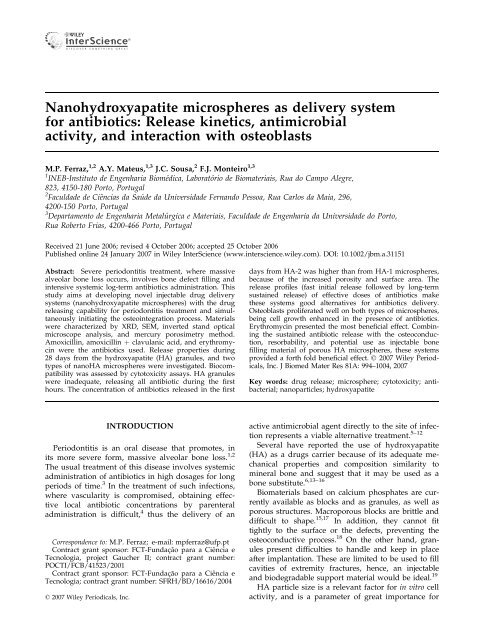

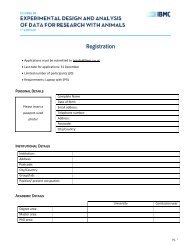

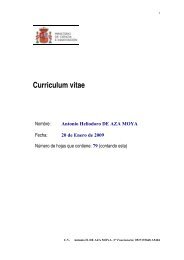
![registration form - download [pdf] - IBMC](https://img.yumpu.com/22442689/1/184x260/registration-form-download-pdf-ibmc.jpg?quality=85)
